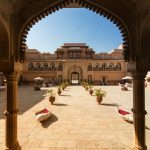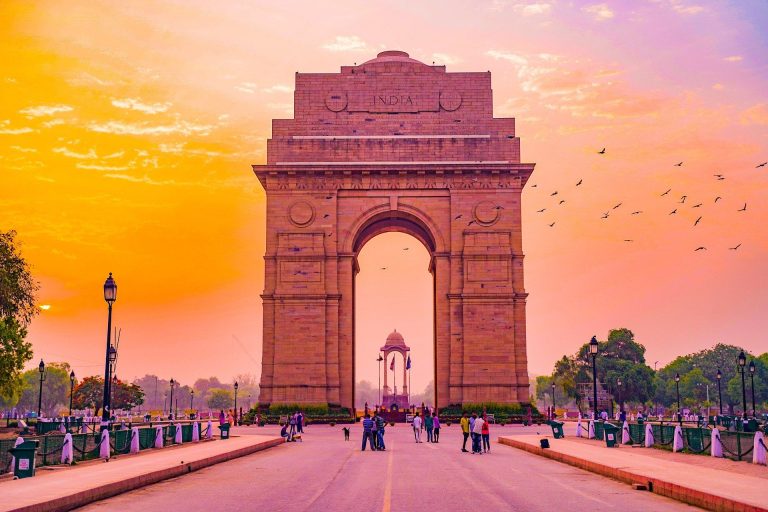Delhi, the capital city of India, is steeped in history, and its monuments are a testament to its rich and diverse past. From towering forts to intricate mosques, there are countless architectural marvels that tell the tales of the city's bygone eras. In this article, we will explore five monuments in Delhi that showcase this vibrant history.
The Red Fort: A symbol of Mughal power and grandeur
The Red Fort, also known as Lal Qila, is a magnificent structure that stands proud as a symbol of India's independence. Built-in 1648 by the Mughal emperor Shah Jahan, it served as the main residence of the Mughal emperors until 1857. This UNESCO World Heritage Site is an architectural marvel, with its red sandstone walls and intricate designs.
Walking through the massive gate of the Red Fort, known as the Lahori Gate, one can't help but be in awe of the grandeur that surrounds them. The fort complex houses various buildings, including the Diwan-i-Aam (Hall of Public Audience) and the Diwan-i-Khas (Hall of Private Audience), showcasing the opulence and power of the Mughal empire.
The sound and light show held every evening at the Red Fort is a must-see experience, where the history of Delhi and the fort itself is brought to life through captivating storytelling. From the beautiful gardens to the stunning architecture, the Red Fort is a testament to the rich history of Delhi.
Qutub Minar: A testament to Delhi's architectural brilliance
Standing tall at a height of 73 meters, the Qutub Minar is an iconic tower of victory that dates back to the 12th century. Built by Qutub-ud-din Aibak, the first ruler of the Delhi Sultanate, this towering structure is made of red sandstone and marble, and its intricate carvings and awe-inspiring architecture make it a favorite among history buffs.
The Qutub Minar is surrounded by several other historical structures, including the Quwwat-ul-Islam Mosque, which is one of the oldest mosques in India. The complex also houses the Iron Pillar, an engineering marvel that has stood the test of time without rusting.
Climbing to the top of the Qutub Minar offers a breathtaking view of the surrounding area, and it is a testament to the architectural brilliance of Delhi's past. The intricate carvings and inscriptions on the minaret tell the stories of the rulers who commissioned its construction and the history of the city itself.
Humayun's Tomb: A fusion of Persian and Indian architectural styles
Humayun's Tomb, another UNESCO World Heritage Site, is a masterpiece of Mughal architecture. Built-in the 16th century, it is the final resting place of the Mughal emperor Humayun. This grand mausoleum is surrounded by beautiful gardens and is a fusion of Persian and Indian architectural styles.
The tomb's stunning red sandstone and white marble structure, along with its intricate lattice work and delicate carvings, make it a sight to behold. The symmetrical layout and the use of Persian elements, such as the high arches and the double dome, add to its grandeur.
Visiting Humayun's Tomb offers a glimpse into the opulent lifestyle of the Mughal rulers and their love for architecture and art. The peaceful ambiance of the surrounding gardens adds to the serenity of the place, making it a must-visit monument in Delhi.
Jama Masjid: India's largest mosque and a symbol of religious harmony
Located in the heart of Old Delhi, the Jama Masjid is one of the largest mosques in India. Built by the Mughal emperor Shah Jahan in the 17th century, it is an architectural marvel and a symbol of religious harmony.
The Jama Masjid is made of red sandstone and white marble and can accommodate up to 25,000 worshippers at a time. Its massive courtyard, marble domes, and minarets add to its grandeur. The mosque also houses several relics, including a copy of the Quran written on deer skin.
Visiting the Jama Masjid offers a spiritual experience, whether one is a follower of Islam or not. The peaceful atmosphere and the intricate details of the mosque's architecture leave a lasting impression on visitors.
India Gate: A tribute to the Indian soldiers who sacrificed their lives
India Gate is a prominent landmark in Delhi that pays tribute to the soldiers who sacrificed their lives for the nation. Designed by Sir Edwin Lutyens, it was built in the early 20th century as a memorial to the Indian soldiers who lost their lives during World War I and the Afghan Wars.
The majestic archway stands at a height of 42 meters and is made of red sandstone. The names of the soldiers who died in these wars are inscribed on the walls of the arch. The Amar Jawan Jyoti, an eternal flame, burns day and night under the arch to honor the soldiers.
Surrounded by sprawling gardens, India Gate is a popular spot for locals and tourists alike. Families gather here for picnics, children play, and visitors pay their respects to the soldiers. The beauty of the monument, especially when lit up at night, is a sight to behold.
Exploring the history of Delhi through these monuments
Delhi is a treasure trove of historical sites, and these five monuments are just the tip of the iceberg. Exploring the history of Delhi through these architectural marvels provides a glimpse into the city's past and its transformation over the centuries.
From the grandeur of the Mughal era to the architectural brilliance of the Delhi Sultanate, each monument tells a unique story that unfolds as one delves deeper into the historical context. These monuments are not only a visual treat but also serve as a reminder of the rich cultural heritage of Delhi.
Other historical sites in Delhi worth visiting
While the Red Fort, Qutub Minar, Humayun's Tomb, Jama Masjid, and India Gate are the most well-known monuments in Delhi, there are several other historical sites that are worth visiting.
One such site is the Purana Qila, or the Old Fort, which dates back to the 16th century. It is believed to be the site of the ancient city of Indraprastha, mentioned in the Hindu epic Mahabharata. The fort complex houses several structures, including a mosque and a lake.
Another must-visit site is the Lotus Temple, a Bahá'í House of Worship known for its unique lotus-shaped architecture. It is a place of worship for people of all religions and offers a serene and peaceful atmosphere.
The Agrasen ki Baoli, an ancient stepwell, is another hidden gem in Delhi. It is a historical marvel and a popular spot for photography enthusiasts. The stepwell's intricate design and architectural features make it a fascinating place to visit.
Tips for visiting these monuments
When visiting these historical monuments in Delhi, it is important to plan ahead and take a few precautions:
- Dress modestly: Since these monuments have religious significance, it is advisable to dress modestly and respect the cultural norms.
- Carry water and snacks: Exploring these monuments can be tiring, so it is recommended to carry water and light snacks to keep yourself hydrated and energized.
- Wear comfortable shoes: Most of these monuments require a fair amount of walking, so wearing comfortable shoes is essential.
- Visit during weekdays: Weekends tend to be crowded, so visiting these monuments during weekdays can help you avoid the crowds and have a more enjoyable experience.
- Hire a guide: To truly appreciate the historical significance of these monuments, consider hiring a guide who can provide insights and stories about the architecture and the history.
Conclusion: Discover the historical wonders of Delhi
Delhi's monuments are not just structures made of stone and marble; they are a gateway to the city's rich history and cultural heritage. From the grandeur of the Red Fort to the architectural brilliance of Qutub Minar, each monument tells a unique story that transports visitors to a bygone era.
Exploring these historical sites is a journey back in time, where one can witness the rise and fall of empires, the fusion of architectural styles, and the interplay of religions and cultures. Delhi's monuments are a testament to the city's vibrant past and its enduring legacy.
So, the next time you find yourself in Delhi, make sure to visit these five monuments and immerse yourself in the captivating world of history and architecture that they offer. Let the walls whisper their tales and transport you to a time long gone.




0 Comments